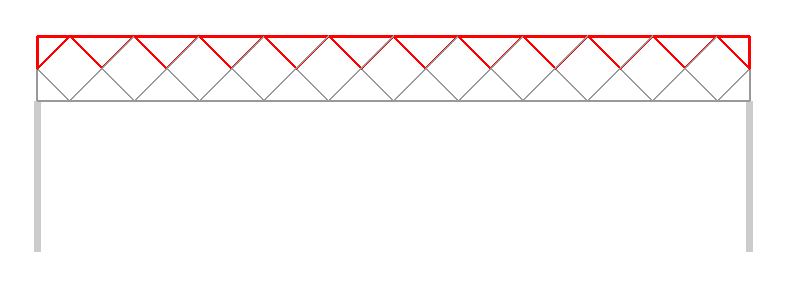Space Frame
Many applications require roofs or covers that are flat, or nearly flat. Space frames provide efficient solutions for these requirements. The most common space frame geometries are called "offset rectangular grids", "square on square space frames", or simply "square grids".
But square grids have a couple of characteristics that may limit their use for the longest spans:
Loads must travel to the supports indirectly. Because the bars in the top and bottom chords of the frame are arranged in a square pattern, the load takes a stepped route to the supports, much like a taxicab downtown trying to go diagonally.
The depth is limited to less than the width of the module. Because the diagonal "web" bars connect neighboring nodes in the opposite layer, increasing the depth results in impossibly large nodes and heavy webs.
With the Geometrica system, it is possible to overcome each of these disadvantages, and thus use square grids for longer spans by modifying the conventional square grid as follows:
Increased chord density
In order to build a square grid that can transfer loads diagonally, we can take advantage of the Geometrica joint's capacity to resist bending moments. Square grids in each layer of chords can be reinforced with diagonal elements that are not directly connected to the webs. This stiffens the grid against twist, increases the density of the bending-resisting elements, and allows for longer spans.
Varying depth
The top chord of space frames may be sloped to provide a deeper section at the middle of the span as well as positive drainage.
Double depth
The depth of the frame layer of webs and chords. The additional depth increases the second moment of area of the space frame, increasing the possible span substantially. Chords in the middle of the double depth frame may be removed because the Geometrica joint can resist bending. And because web members in the Geometrica system may be very light and slender, the increased web count does not result in significant additional weight.
Camber
The "flat" space frame may be manufactured with a slight deformation in the direction contrary to the expected deflection under service loads. This eliminates any possible unsightly sag of the structure, particularly for the longer spans. Camber may be applied to either or both chord layers of a space frame.
Any set of the above modifications may be combined into very stiff, strong and light space frames. For example, the Swift Group's hangar at Skyharbor in Phoenix is designed to span 50m with dense top chord, varying depth and camber.
Another space frame geometry commonly used is the triangular grid. Because of their triangular pattern, these grids can resist in-plane twist. But as in square grids, their depth is limited and, for a large portion of their extent, they often contain more web members than are necessary to carry the load. In order to overcome these disadvantages, triangular grids may also benefit from the modifications available to square grids. See section on domes for some of the variations in triangular grids.
Swift Aviation Hangar, Phoenix
What can Geometrica do for you? If you would like more information, please fill our inquiry form.






